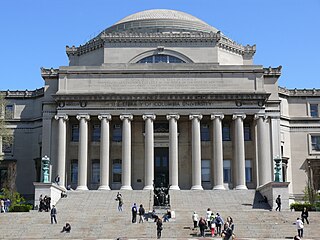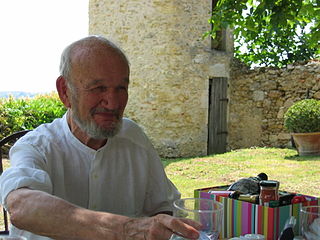Related Research Articles

Barnard College of Columbia University is a private women's liberal arts college located in the borough of Manhattan in New York City. It was founded in 1889 by a group of women led by young student activist Annie Nathan Meyer, who petitioned Columbia University’s trustees to create an affiliated college named after Columbia’s recently deceased 10th president, Frederick A.P. Barnard.

Columbia University is a private Ivy League research university in New York City. Established in 1754 as King's College on the grounds of Trinity Church in Manhattan, Columbia is the oldest institution of higher education in New York and the fifth-oldest institution of higher learning in the United States and is considered one of the most prestigious schools in the world. It is one of nine colonial colleges founded prior to the Declaration of Independence, seven of which belong to the Ivy League. Columbia is ranked among the top universities in the world.

The Municipal Art Society of New York (MAS) is a non-profit membership organization for preservation in New York City, which aims to encourage thoughtful planning and urban design and inclusive neighborhoods across the city.
The Juilliard School is a private performing arts conservatory in New York City. Established in 1905, the school trains about 850 undergraduate and graduate students in dance, drama, and music. It is widely regarded as one of the world's leading drama, music, and dance schools.

Stuyvesant High School, commonly referred to among its students as Stuy, is a public magnet, college-preparatory, specialized high school in New York City, United States. Operated by the New York City Department of Education, these specialized schools offer tuition-free accelerated academics to city residents.

Columbia Grammar & Preparatory School is the oldest nonsectarian independent school in New York City, located on the Upper West Side of Manhattan. The school serves grades Pre-kindergarten to 12 and offers a college preparatory curriculum.
An editor-in-chief, also known as lead editor or chief editor, is a publication's editorial leader who has final responsibility for its operations and policies.
Columbia University in New York City has an extensive tunnel system underneath its campus connecting many of its buildings, used by the university as conduits for steam, electricity, telecommunications, and other infrastructure. Similar tunnels also exist under the affiliated Barnard College. Though sections have been cordoned off by the university, either in response to the 1968 protests or rampant campus typewriter theft, many parts can still be accessed by students.

Columbia University Vagelos College of Physicians and Surgeons (VP&S) is the graduate medical school of Columbia University, located at the Columbia University Irving Medical Center in the Washington Heights neighborhood of Manhattan. Founded in 1767 by Samuel Bard as the medical department of King's College, VP&S was the first medical school in the Thirteen Colonies to award the Doctor of Medicine (MD) degree. Beginning in 1993, VP&S was also the first U.S. medical school to hold a white coat ceremony.

The New School is a private research university in New York City. It was founded in 1919 as The New School for Social Research with an original mission dedicated to academic freedom and intellectual inquiry and a home for progressive thinkers. Since then, the school has grown to house five divisions within the university. These include the Parsons School of Design, the Eugene Lang College of Liberal Arts, the College of Performing Arts, The New School for Social Research, and the Schools of Public Engagement.
The Latin adverb sic inserted after a quoted word or passage indicates that the quoted matter has been transcribed or translated exactly as found in the source text, complete with any erroneous, archaic, or otherwise nonstandard spelling, punctuation, or grammar. It also applies to any surprising assertion, faulty reasoning, or other matter that might be interpreted as an error of transcription.
In 1968, a series of protests at Columbia University in New York City were one among the various student demonstrations that occurred around the globe in that year. The Columbia protests erupted over the spring of that year after students discovered links between the university and the institutional apparatus supporting the United States' involvement in the Vietnam War, as well as their concern over an allegedly segregated gymnasium to be constructed in the nearby Morningside Park. The protests resulted in the student occupation of many university buildings and the eventual violent removal of protesters by the New York City Police Department.
Columbia Daily Spectator is the weekly student newspaper of Columbia University. It is published at 120th and Claremont in New York, New York. Founded in 1877, it is the oldest continuously operating college news daily in the nation after The Harvard Crimson, and has been legally independent of the university since 1962. During the academic term, it is published online Sunday through Thursday and printed once monthly. In addition to serving as a campus newspaper, the Spectator also reports the latest news of the surrounding Morningside Heights community. The paper is delivered to over 150 locations throughout the Morningside Heights neighborhood.

St. Paul's Chapel, on the Morningside Heights campus of Columbia University in Manhattan, New York City, is an Episcopal church built in 1903–07 and designed by I. N. Phelps Stokes, of the firm of Howells & Stokes. The exterior is in the Northern Italian Renaissance Revival style while the interior is Byzantine.

Butler Library is located on the Morningside Heights campus of Columbia University at 535 West 114th Street, in Manhattan, New York City. It is the university's largest single library with over 2 million volumes, as well as one of the largest buildings on the campus. It houses the Columbia University Libraries collections in the humanities, history, social sciences, literature, philosophy, and religion, as well as the Columbia Rare Book and Manuscript Library. The Neoclassical style building was built in 1931–1934 to a design by James Gamble Rogers. Butler Library remains at least partially open 24 hours a day during the academic year.

The Low Memorial Library is a building on the campus of Columbia University in Morningside Heights, Manhattan, New York City, United States. The building was designed by Charles Follen McKim of the firm McKim, Mead & White, and was constructed between 1895 and 1897 as the university's central library. University president Seth Low funded the building with $1 million and named the edifice in memory of his father, Abiel Abbot Low. The university's central administrative offices are housed in the building, which is located near 116th Street between Broadway and Amsterdam Avenue. Low's facade and interior are New York City designated landmarks, and the building is also designated as a National Historic Landmark.

Alma Mater is a bronze sculpture by Daniel Chester French which is located on the steps of the Low Memorial Library on the campus of Columbia University, in the Morningside Heights neighborhood of Manhattan, New York City. French designed the statue in 1901, and it was installed in September 1903. It is a personification of the alma mater, which represents Columbia in its role as an educational institution; since its installation, the statue has become closely associated with the image of the university.

Norval Crawford White was an American architect, architectural historian and professor. He designed buildings throughout the U.S., but he is best known for his writing, particularly the AIA Guide to New York City. White was widely considered to be one of the great figures of New York architecture.
Columbia University in New York City, New York, has seen numerous instances of student protests, particularly beginning in the late 20th century.

The Class of 1885 Memorial Sundial is a landmark at Columbia University, located at the center of the College Walk at the other end of Butler Plaza from Butler Library. Designed by astronomy professor Harold Jacoby in conjunction with McKim, Mead & White, it was completed in 1914. The 16-short-ton (15 t) granite sphere that once sat on top of it, at some point considered the largest stone sphere in the world, was removed in 1946 after it began to crack; efforts have been made toward its recovery since it was rediscovered in Michigan in 2001. The sundial's bare platform now serves as a popular meeting area for students, as well as a center for campus politics.
References
- Kilgannon, Corey (March 7, 1999), "To Sell A Guidebook, A Dose Of Attitude", The New York Times
- Busis, Hillary (September 22, 2009), "'Inside New York' takes students outside the bubble", Columbia Daily Spectator, archived from the original on December 13, 2009, retrieved October 27, 2009